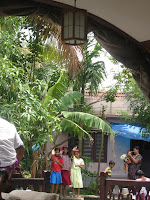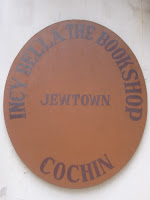
Eimer and I are delighted that our summer skirts and tank tops draw no unsettling stares, and Andrew points out, quite rightly, that if Cochin were all you saw of India, you’d wonder what all the fuss was about. What’s all this about India being inconceivably crowded? But to those of us who know better, Kerala is a welcome respite.
We leave the office at noon on a Friday – proper expat style – though only because our 5pm Paramount flight is cancelled and we are forced to rebook on the IndiGo 2pm. Luckily, Eimer is notified of the flight’s cancellation with ample time to rebook, as the friendly folk at Paramount deign to ring me just as I am boarding the IndiGo plane and query, rather sheepishly, “Ma’am…did you cancel your flight?”
“Er, no…you did.”
“Sorry ma’am. Goodbye, ma’am”
Little strange…but that’s India for you.
The languorous strolling of the locals and the easy smiles of the foreigners set the mood in Fort Kochin, and we plan to take it easy Friday night. After a quick rick-trip to the pharmacy (all but a street stall), where Eimer purchases some unidentified ‘NoCold’ tablets to pull the plug on her streaming nose, we dine at the Old Courtyard. The food is savoury but the same cannot be said for our dinner conversation, during which Andrew and Eimer enlighten me on the ‘bucket of water in every bathroom’ phenomenon. Apparently, the pervasive absence of toilet paper is no oversight, and the bucket is for a quick post-wipe wash of the left hand. I’m still not sure I believe it…
We’re a touch late for the evening’s entertainment: a traditional Indian music concert at the Kerala Kathakali Centre, which I thoroughly enjoy. The three musicians, barefoot and sitting cross-legged on stage, all have bushy black moustaches and facial expressions that complement the music coming from their instruments. The drummer’s swift fingers are particularly mesmerising; moving like a hummingbird’s wings, they fly across the drums’ taut surface, blurring my vision.
 Liquor licenses are few and far between in Fort Kochin, so after the show, we proceed to sneakily drink rather flat, warm ‘Kingfisher’ from kitchen-green mugs at a bare-bones eatery stationed directly adjacent to a sleepy police station. The beer’s rank but the company’s pleasant and by the time we’ve made our way through 3 coffeepots of beer, Eimer, for one, is ready to party.
Liquor licenses are few and far between in Fort Kochin, so after the show, we proceed to sneakily drink rather flat, warm ‘Kingfisher’ from kitchen-green mugs at a bare-bones eatery stationed directly adjacent to a sleepy police station. The beer’s rank but the company’s pleasant and by the time we’ve made our way through 3 coffeepots of beer, Eimer, for one, is ready to party.The word on the street names Le Meridien (across the water in Ernakulam) as THE place to party till the wee hours of the morning. Life may be a never-ending battle between a good night’s sleep and an even better party, but in Kerala, it is circumstance not choice that favours the former. When Eimer, Andrew and I arrive at Le Meridien, it is just past midnight, the club boasts a hopping crowd of seven and the bar has just closed. Having given the good party a fair go, I am actually quite pleased that a good night’s sleep wins out this time.
On Saturday morning, I take a little solo walk to view Fort Kochin’s infamous Chinese fishing nets and on the way back to guest house breakfast, I take a real liking to a Keralan’s green T-shirt that proclaims in gold decal: God is a DJ.


Before leaving Fort Kochin we stop to pick up real, cold beer from the liquor store adjacent to a government official’s house. Following a two-hour, Hindi love-song accompanied drive to Alleppey, Andrew, Eimer and I board our very own houseboat, government approved beer in hand. The houseboat, equipped with bedrooms, bathrooms, a kitchen, a deck/dining room/lounge, and a staff of 4 is our home for the next 24 hours, as we cruise at an indulgent Keralan pace along the backwaters of Alleppey.

The network of inland waterways, despite what connotation its name may impart, is a little green slice of paradise - palm-lined and alive with villager activity. I spend hours engaged in blissful nothingness – watching the palms pass me by, waving back at the smiling Indians on the shore and wondering about all the other small divinities of the world, neatly tucked away as are the backwaters of Kerala.






I do find myself longing for a scrabble set as the afternoon wears on, but when I voice the desire, Andrew parries, “Why you gotta hate nature?” He has a point, and in retrospect, I am glad to have been so ‘ill-prepared’ for a day of floating. I am not as glad that I let my guard down and paid a whopping 900 roops for 4 (albeit jumbo jumbo) freshwater prawns.


Sunday morning, I am on a mission to get to the Fort Kochin synagogue before it shuts its doors at noon. Our driver is on a mission to take a few detours and increase kms (and thus payment), but despite our somewhat competing missions, we do arrive at the synagogue with 15 minutes to spare. It’s small, but lovely and serene. Coloured glass chandeliers hang all around the sanctuary and the floors are tiled with blue and white Asian (Ming style) tiles. With a grand tally of 13 men, the community is dying, but the area of Fort Kochin is still called Jew Town (as per maps and road signs.)

In addition to the synagogue, Jew Town is home to eclectic antique & home shopping. I am quite taken by china doorknobs, silk-embroidered elephant-shaped tea cosies, 5 foot wooden goddess statues, and a 6.5 foot laughing Buddha, but as I have no home to ship them to, I stick to taking photographs of the items I’d much prefer to purchase.
And I find that even in peaceful Kerala, I am conflicted. The beautiful backwaters manage somehow to make me nervous. They are a reminder of all that I have yet to see and discover in the world; they urge me to continue travelling and wandering, experiencing as much as I can of the places and the people and the ways of life that are out there. But in the bazaars of Jew Town, I long to acquire the junk that makes a house a home, all the sorts of weighty, material accoutrements one forsakes when truly devoted to a nomadic, unfettered existence.

It’s a tougher tug of war than the good night’s sleep vs. an even better party one, and I do wonder just how long I am destined to continue feeling/being on the road.
















